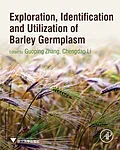Exploration, Identification and Utilization of Barley Germplasm explores the timely global challenges related to barley production posed by the narrowing of biodiversity and problem soils, identifying elite genotypes which will enhance barley breeding and be essential to genetic and evolution studies. The book covers the utilization of barley germplasm for improving the quality of both food and feed barley as well as exploring and utilizing varieties of germplasm that are tolerant to drought, waterlogged, salt, and acid soil. Chapters are devoted to prime strategies for future research, including identifying barley germplasm by applying Omics, exploring barley germplasm by means of the Focused Identification of Germplasm Strategy (FIGS), and creating barley germplasm through mutation. Users will find this book to be a key research reference for both professionals and academics, providing a comprehensive update for established barley researchers that equips them with an understanding of the new methodologies needed for innovation and discovery, while also providing a helpful entry to the subject for young researchers and students. - Provides a one-stop shop to acquire a speedy overview of the main and recently applied issues of barley breeding - Provides newly-developed methodologies in barley germplasm research - Describes special genotypes from wild barley, including Tibetan wild barley, which show a high tolerance to abiotic stresses and carry different alleles from cultivated barley
Autorentext
Prof. Guoping Zhang is a Professor at Zhejiang University, China. His major research interests include: (1) identification and development of barley germplasm with abiotic stress tolerance (salinity, acid soils and drought) and high nutrient use efficiency, and (2) genotypic difference and molecular mechanisms of heavy metal accumulation and tolerance in plants. In the past two decades, He finished more than 30 research projects, including 13 granted by China Natural Science Foundations, and published more than 270 papers in peer-reviewed journals, with more than 6,000 citations. He once acted as a chairman of organizing committee for International Barley Genetics Symposium (2012-2016) and is now on the editorial board of several journals, including Journal of Agronomy and Crop Science, Plant Growth Regulation, and Journal of Integrative Agriculture.
Klappentext
Exploration, Identification and Utilization of Barley Germplasm explores the timely global challenges related to barley production posed by the narrowing of biodiversity and problem soils, identifying elite genotypes which will enhance barley breeding and be essential to genetic and evolution studies.
The book covers the utilization of barley germplasm for improving the quality of both food and feed barley as well as exploring and utilizing varieties of germplasm that are tolerant to drought, waterlogged, salt, and acid soil. Chapters are devoted to prime strategies for future research, including identifying barley germplasm by applying Omics, exploring barley germplasm by means of the Focused Identification of Germplasm Strategy (FIGS), and creating barley germplasm through mutation.
Users will find this book to be a key research reference for both professionals and academics, providing a comprehensive update for established barley researchers that equips them with an understanding of the new methodologies needed for innovation and discovery, while also providing a helpful entry to the subject for young researchers and students.
- Provides a one-stop shop to acquire a speedy overview of the main and recently applied issues of barley breeding
- Provides newly-developed methodologies in barley germplasm research
- Describes special genotypes from wild barley, including Tibetan wild barley, which show a high tolerance to abiotic stresses and carry different alleles from cultivated barley
Inhalt
1. Domestication of wild barley and improvement of cultivated barley 2. Malt barley quality improvement and germplasm utilization 3. Food barley quality improvement and germplasm utilization 4. Feed barley quality improvement and germplasm utilization 5. Functional chemical composition and germplasm utilization 6. Exploration and utilization of salt tolerant barley germplasm 7. Exploration and utilization of drought tolerant barley germplasm 8. Exploration and utilization of waterlogging tolerant barley germplasm 9. Exploration and utilization of acid soil tolerant barley germplasm 10. Exploration and utilization of low temperature tolerant barley germplasm 11. Application of Omics in identification of barley germplasm 12. Focused Identification of Germplasm Strategy (FIGS) for exploration of barley germplasm 13. Create barley germplasm through mutation
